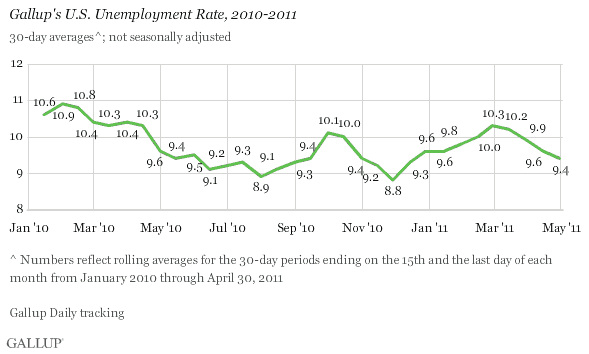PRINCETON, NJ -- Unemployment, as measured by Gallup without seasonal adjustment, fell to 9.4% at the end of April from 9.6% in mid-April and 9.9% at the end of March. Unemployment is now at its lowest level of 2011 and is lower than the 9.6% at the end of April last year.

The percentage of part-time workers who want full-time work increased to 9.9% at the end of April -- up from 9.6% in mid-April and 9.1% at the end of March. More U.S. workers are now working part time but seeking full-time work than was true a year ago (9.3%).

Broader Underemployment Still High in April
The decline in unemployment since late March was not enough to offset the increase in those working part time but wanting full-time work. As a result, the combined underemployment measure was 19.3% at the end of April -- essentially the same as the 19.2% in mid-April and slightly higher than the 19.0% at the end of March. Underemployment is now higher than the 18.9% at the end of April a year ago.

Jobs Situation Not Much Different Than a Year Ago
There has been a relatively modest decline in unemployment over the first four months of 2011, and that improvement may be at least partly the result of seasonal hiring factors. There was a similar downward trend in Gallup's not-seasonally adjusted unemployment measure over the same four-month period in 2010. This similarity in trends also holds for Gallup's Job Creation Index and broader underemployment over the same time frames.
These trends are consistent with the Challenger report for April that showed fewer workers being let go than in March and slightly fewer than in April a year ago, and the ADP report that found a less-than-expected 179,000 increase in private-sector hiring during April. While layoffs are down, businesses continue to hold back on their hiring in the U.S.
Although the jobs situation has been relatively flat in 2011 -- not much better than in 2010 and with an increasing number of people working part time but wanting full-time work -- even marginal job growth is good, given the slow growth of the first quarter of this year. At a time when the U.S. economy is facing numerous economic headwinds, including plummeting consumer confidence and soaring food and gas prices, the challenge may be to maintain this performance during the months ahead.
Gallup.com reports results from these indexes in daily, weekly, and monthly averages and in Gallup.com stories. Complete trend data are always available to view and export in the following charts:
Daily: Employment, Economic Confidence and Job Creation, Consumer Spending
Weekly: Employment, Economic Confidence, Job Creation, Consumer Spending
Read more about Gallup's economic measures.
View our economic release schedule.
Survey Methods
Gallup classifies American workers as underemployed if they are either unemployed or working part time but wanting full-time work. The findings reflect more than 18,000 phone interviews with U.S. adults aged 18 and older in the workforce, collected over a 30-day period. Gallup's results are not seasonally adjusted and are ahead of government reports by approximately two weeks.
Results are based on telephone interviews conducted as part of Gallup Daily tracking from April 1-30, 2011, with a random sample of 18,850 adults, aged 18 and older, living in all 50 U.S. states and the District of Columbia, selected using random-digit-dial sampling.
For results based on the total sample of national adults, one can say with 95% confidence that the maximum margin of sampling error is ±1 percentage point.
Interviews are conducted with respondents on landline telephones and cellular phones, with interviews conducted in Spanish for respondents who are primarily Spanish-speaking. Each sample includes a minimum quota of 400 cell phone respondents and 600 landline respondents per 1,000 national adults, with additional minimum quotas among landline respondents for gender within region. Landline telephone numbers are chosen at random among listed telephone numbers. Cell phone numbers are selected using random-digit-dial methods. Landline respondents are chosen at random within each household on the basis of which member had the most recent birthday.
Samples are weighted by gender, age, race, Hispanic ethnicity, education, region, adults in the household, and phone status (cell phone only/landline only/both, cell phone mostly, and having an unlisted landline number). Demographic weighting targets are based on the March 2010 Current Population Survey figures for the aged 18 and older non-institutionalized population living in U.S. telephone households. All reported margins of sampling error include the computed design effects for weighting and sample design.
In addition to sampling error, question wording and practical difficulties in conducting surveys can introduce error or bias into the findings of public opinion polls.
For more details on Gallup's polling methodology, visit https://www.gallup.com/.
